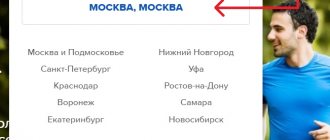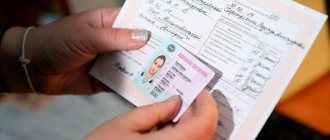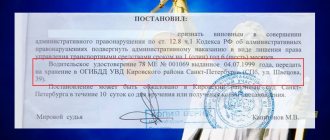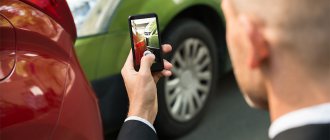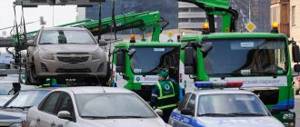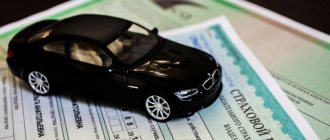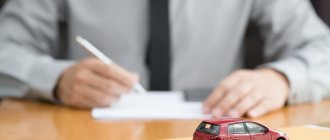Characteristics of a fake accident
Victims of intentional road accidents most often become drivers traveling alone, distracted by a conversation on a mobile phone, without driving experience (with a “U” sign on their car) or taxi drivers. Fraudsters create certain situations in which the insurance company is obliged to pay compensation. Some citizens try to resolve the issue “amicably” on the spot and give large sums of money to the criminals as damages. The main types of fraud are:
- Taking out insurance for a car retroactively, when it has already been involved in an accident. This is done to shift responsibility from the driver to the company.
- False accidents for insurance with a substitute driver. Often, during an accident, a person who is not included in the policy is driving. In this case, no payment is made, and therefore the scammers in this situation put the person whose details are included in the policy behind the wheel. It is very difficult to prove a violation here.
- Bank or insurance document scam. The employees themselves are usually involved in the setup, falsifying the results of the examination in order to receive higher compensation for minor injuries.
You can protect yourself from fraud associated with road accidents by installing a DVR, calling traffic police officers to the place where questionable actions are taking place, recording everything on a mobile phone camera, and also involving strangers as witnesses.
What is an auto stand
Any traffic accident, the purpose of which is to obtain money, committed intentionally and planned in advance can be classified as a car set-up.
Typically, in the event of such an accident, there is minor damage and no injuries. This was done in order to receive money from the driver on the spot without contacting traffic police inspectors and further litigation with insurance companies.
Often, the victims of scammers are drivers who are driving without passengers , who clearly insecure behind the wheel, who are either talking on a cell phone while driving, or who are simply noticeably distracted .
Popular auto setup schemes
For a fake accident, the perpetrators face serious consequences, but this stops few people. Fraudsters often use proven “working” schemes to deceive citizens or insurance companies. The most common of them are:
- Staging an accident. This is a deliberate decision to deteriorate the condition of the car in order to present it as a victim in an accident. In such a situation, it is important to find witnesses who will confirm the absence of a traffic accident. Then the scammers will not receive money from the insurance company.
- Double payments. Often after an accident, the parties agree to resolve the conflict without involving traffic police officers. In such a situation, the culprit gives a certain amount of money on the spot and leaves. After this, the victim calls the traffic police and draws up a report: thus, collecting compensation for the damage caused again.
- Taking out a policy for a damaged car. If an uninsured vehicle is damaged in an accident, many culprits try to hide this fact by concluding an MTPL agreement with the company and collecting compensation from it. For everything to go smoothly, one of the company’s employees must be at the same time as the attackers.
- Fraudulent theft. The fraud lies in the fact that a CASCO agreement is concluded. After this, the transport is disassembled for spare parts or exported abroad. In this case, the owner contacts law enforcement agencies and reports the car theft, after which he formalizes payment of compensation.
Attention! Staging an accident for the insurance company is the most common type of fraudulent activity. In this situation, either one or both parties may know about the illegality. When the criminals are caught, each swindler will suffer the prescribed punishment. In most cases, automatic scams are easily discovered, since many schemes are not fully thought out and do not take into account hundreds of nuances.
How to recognize a fake car on the road
Most often, it is not easy to notice the wiring. Fraudsters pull everything off so skillfully that even an experienced person has a hard time figuring out their maneuvers.
How to avoid becoming a victim of scammers who set up car scams on the roads?
Existing methods that can help you protect yourself from fraud:
- Suspicious actions are being taken against your car by someone else's car with tinted windows. The number is not visible or is missing altogether. This is probably a car accident that happens on the road.
- You are driving your car without violating traffic rules, and suddenly an unfamiliar Audi, BMW or Mercedes brazenly tries to push you to the side of the road.
- After the collision, passengers try to take you away and offer to go somewhere.
- After an accident, they want to lure you out of the car.
- The driver of the car you accidentally crashed into suggests calling the insurance company instead of the traffic police.
- A clear sign of a car scam on the road is that the driver persistently demands reimbursement for repairs (for welding and painting). This is pronounced strictly in an ultimatum form. We need money right now. And this is instead of calling the insurance company and the State Traffic Inspectorate.
- Your car is only slightly scratched, but their car has significant damage.
- When you refuse to follow the instructions of the scammers, threats begin to pour in.
These are the most common fraudulent schemes. Be more careful when encountering criminals involved in car fraud on the roads. Don't fall for their bait.
Staging an accident with the consent of the participants
One of the ways to deceive on the road is to fake an accident by agreement of the parties. The idea is to get double the benefits. It is formed due to the fact that the victim offers the culprit (often in a drunken state) to settle everything at once. If he agrees and pays compensation on the spot, the fraudster waits until he leaves and calls the traffic police. The protocol records the fact of leaving the scene of the accident. In addition to the amount already received, the victim makes a payment to the insurance company.
The essence of the auto setup
Although this term is unofficial, it is used in relation to all types of fraud associated with staging an accident and subsequent extortion of money from the “victim” or even from the insurance company. Let us immediately note that not only existing loopholes in legislation and traffic rules help criminals to carry out their plans, but also an excellent knowledge of human psychology, and often it is the second factor that is the main one. For an unprepared driver, such auto scams always happen very quickly and unexpectedly, and scammers skillfully take advantage of the confusion of their victim. And most often they succeed - in fake car accidents, they use a variety of methods to influence the psyche, including methods of outright intimidation. The main thing is to make the driver believe that if he contacts the insurance company or the traffic police, he will have much more problems, so it is better to try to solve the problem by paying the required amount.
Punishment for a fictitious accident
An intentional road accident is revealed very quickly, and all participants will face punishment as determined by law. Some people think that this is only administrative responsibility, but such actions are often classified as criminal. What is the penalty for falsifying an incident on the road:
- Penalties up to 120 thousand rubles.
- Performing mandatory work up to 300 hours.
- Compensation for expenses and damages incurred in the amount of the annual income of the person responsible for the accident.
- Forced labor for a year.
- Correctional labor for up to 1.5 years.
- Imprisonment for a period of 6 months.
Such consequences are provided for by the provisions of the Code of Administrative Offenses and the Criminal Code. Based on the situation, by court decision, they can be deprived of liberty for a longer period. Members of a criminal gang, for example, receive up to 10 years in prison if they systematically set up road accidents over several years.
How to avoid auto fraud
Road accidents are created deliberately in order to make money. The situations are staged and are most often intended for drivers who violate traffic rules and do not want to call the traffic police. Therefore, it is extremely important to always comply with established regulations. Then, if there is a suspicion of unlawful actions, you can notify law enforcement agencies without fear.
Advice! Another effective way to protect yourself from scammers is to purchase and install a high-quality DVR.
When certain actions on the road are performed intentionally, they are necessarily recorded by this device. It will be much easier to prove you are right later. In case of inappropriate behavior of the other party, the best solution is to lock yourself in the car and wait for the police to arrive.
How to avoid setups on the road?
Paradoxically, all the advice on this topic is quite banal and simple. The first thing you should remember is that absolutely anything can happen on the road. And this should not drive you into panic and constant tension, nor should it unduly relax you, since through experience and skill you can get out of any situation.
Here are simple recommendations that will help you avoid getting caught on the roads:
- Follow the rules of behavior on the road - speed limit, distance, carefully monitor the situation on the road, do not be distracted by phone calls or writing messages while driving, then it will be quite difficult to set you up. The more confident you are on the road, the less likely it is that you will be chosen as a victim.
- Monitor the situation on the road. Substitutes never immediately go on the attack; they first take a closer look at the object and assess the likelihood of their own success.
- Look carefully in the mirrors; it’s not that difficult to figure out what the car was. In most domestic cars, standard mirrors do not provide the proper level of control over the situation on the road. Therefore, you should not spare money on buying better ones that will save you from dead spots while driving. You will save much more money, time and nerves if you do not become a victim of a scam.
- Keep your distance. In relation to the other car, you must be at such a distance that if you brake sharply, you will not cause an accident. The greater the distance, the more time you will have to react to unusual behavior on the road.
- Remain calm even if a car appears behind you, shining and flashing all its high/low or fog lights at you. According to traffic rules, you are obliged to give way only to special vehicles with flashing blue lights. In other cases, you should not be nervous, because it is not you who is in a hurry, but the other driver. In any case, it is better to follow the rules and possibly run into anger and insults from the window of a passing car than to become the culprit of an accident. Therefore, follow the rules and conduct all maneuvers on the road calmly and safely.
- Do not drive in the left lane if you can drive in the right lane, especially since traffic around the city is often faster there.
If you get into a set-up or an accident (and you don’t understand that it’s a set-up), then stay in place and don’t move, don’t move to the side, don’t agree to go to some “your” service, don’t give in to any persuasion. Call the traffic police and stay where you are. Remember that for leaving the scene of an accident you can lose your license for up to 1.5 years. Take your own photo or video from the scene of the accident. Follow the paperwork process carefully. If you suspect that the traffic police officers are in league with the “victim,” call and complain. Inform those present of your intention to write complaints to all possible authorities, including the Traffic Police Internal Security Service. By the way, carry with you all the telephone numbers of services that may be needed in an emergency - the main services, the district traffic police, the operational duty officer. Even the fact of calling the RUOP quickly calms down the attackers. If possible, tell your friends and relatives all the information about the car, the fact of the accident and other participants; if possible, contact your company’s security service.
- When communicating with the “victims”, behave naturally, there is no need to pretend to be tough and threaten with a showdown and your connections anywhere. Try to ignore threats and attempts to trick people into pity, playing “good cop and bad cop”; you must understand that this is just an attempt to exert psychological pressure.
- Remember that scammers may not always extort money; they may simply steal valuables or money from your car. Therefore, do not panic and block the doors every time you leave the salon. If you encounter aggression from participants in the conflict, then lock yourself in the car and call the police.
How to prove you're right if you've been framed
After an accident, the driver, suspecting a staged situation, must immediately call the traffic police, even if everything is arranged in such a way that he looks like the culprit. Before their arrival, it is necessary to record all the circumstances on a mobile phone camera, clarify the testimony and personal data of witnesses. It is strictly forbidden to move vehicles or change the position of objects related to the accident. If the other party does this, then such actions must be recorded on video.
It is also worth informing the insurance company about the incident, calling trusted persons and clarifying all the details of the second party to the accident. Involve third-party people as witnesses to what is happening, it is advisable that they be eyewitnesses. Only if you follow all the recommendations will it be much easier to prove your innocence.
Fraudulent accidents are not uncommon in our country, so every driver needs to know the basic schemes of scammers and not agree to resolve controversial situations on the spot without the involvement of traffic police officers. Otherwise, there is a risk of falling into the hands of scammers or unwittingly becoming their accomplice.
Main types of car insurance fraud
Today, many fraud schemes have been invented. The most commonly used illegal actions are:
Staging an accident, replacing the driver. After an accident, the place of the person sitting behind the wheel is taken by the driver whose details are included in the insurance policy. This method is widely practiced in large cities, since it is almost impossible to prove the fact that the driver was replaced.
The car receives minor damage, followed by deliberate damage to the car as a result of a fictitious accident.
Scams directly involving forms and insurance documents. Unfortunately, insurance company employees are not always law-abiding. Cases of deliberate damage to forms and falsification of examination results after an accident have become more frequent.
There are many ways to recognize an illegal scheme; for example, specialists from expert commissions use special computer programs that allow them to recognize discrepancies in vehicle damage. The detection of fraudulent schemes is hampered by the lack of a unified database of insured vehicles.
It is difficult to recognize scammers; several cars are involved in the staging, and they often resort to the help of unscrupulous traffic police officers and insurance companies. The following situations can be considered signs of auto-fraud:
Persistent requests to give way to a car moving behind; the accomplices' car is moving on the right. As soon as the driver begins the lane change maneuver, the car is suddenly exposed to impact;
Unreasonable sudden braking of the vehicle in front;
The presence of witnesses telling deliberate lies;
Insistent demands of the “victims” to resolve the issue on the spot, without involving traffic police officers.
Overly emotional or aggressive behavior of the “victims” should also alert the driver. Most often, the damage to the scammers' car is minimal, but they try to convince the victim otherwise.
